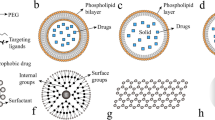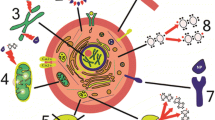Abstract
We have investigated the possibility that photoexcited titanium dioxide (TiO2) could inhibit the growth of malignant cells. We studied the anti-glioma effects of nano-TiO2 excited with ultraviolet A (UVA) irradiation both in vitro and in vivo. Transmission electron microscopy demonstrated that glioma cells take up TiO2 by phagocytosis, and vital staining revealed that TiO2 alone has no effect on glioma cell proliferation. However, if TiO2 was combined with UVA irradiation the proliferation rate was decreased significantly compared to controls (P < 0.05). RT–PCR suggested that TiO2 induction of glioma cell apoptosis is associated with changes in the expression of genes encoding Bcl-2 family members. We then investigated the in vivo antitumor effects of combined TiO2 plus UVA treatment of established glioma tumors. TiO2 plus UVA led to pronounced areas of necrosis, elevated indices of apoptosis, delayed tumor growth, and increased survival compared with the TiO2-alone control group (P < 0.001). Log-rank survival analysis showed that median survival duration was prolonged (P < 0.001). These findings suggest that nano-TiO2 based photodynamic therapy has potential in the treatment of glioma.





Similar content being viewed by others
References
Bondy ML, Scheurer ME, Malmer B, Barnholtz-Sloan JS, Davis FG, Il’yasova D, Kruchko C, McCarthy BJ, Rajaraman P, Schwartzbaum JA, Sadetzki S, Schlehofer B, Tihan T, Wiemels JL, Wrensch M, Buffler PA (2008) Brain tumor epidemiology: consensus from the Brain Tumor Epidemiology Consortium. Cancer 113:1953–1968
Stupp R, Mason WP, van den Bent MJ, Weller M, Fisher B, Taphoorn MJ, Belanger K, Brandes AA, Marosi C, Bogdahn U, Curschmann J, Janzer RC, Ludwin SK, Gorlia T, Allgeier A, Lacombe D, Cairncross JG, Eisenhauer E, Mirimanoff RO (2005) Radiotherapy plus concomitant and adjuvant temozolomide for glioblastoma. N Engl J Med 352:987–996
Tianhu Z, Shiguang Z, Xinghan L (2010) Bmf is upregulated by PS-341-mediated cell death of glioma cells through JNK phosphorylation. Mol Biol Rep 37:1211–1219
Shervington A, Pawar V, Menon S, Thakkar D, Patel R (2009) The sensitization of glioma cells to cisplatin and tamoxifen by the use of catechin. Mol Biol Rep 36:1181–1186
Popovic EA, Kaye AH, Hill JS (1996) Photodynamic therapy of brain tumors. J Clin Laser Med Surg 14:251–261
D’Cruz AK, Robinson MH, Biel MA (2004) mTHPC-mediated photodynamic therapy in patients with advanced, incurable head and neck cancer: a multicenter study of 128 patients. Head Neck 26:232–240
Hertz A, Bruce IJ (2007) Inorganic materials for bone repair or replacement applications. Nanomedicine 2:899–918
Kubota Y, Shuin T, Kawasaki C, Hosaka M, Kitamura H, Cai R, Sakai H, Hashimoto K, Fujishima A (1994) Photokilling of T-24 human bladder cancer cells with titanium dioxide. Br J Cancer 70:1107–1111
Lee YS, Yoon S, Yoon HJ, Lee K, Yoon HK, Lee JH, Song CW (2009) Inhibitor of differentiation 1 (Id1) expression attenuates the degree of TiO2-induced cytotoxicity in H1299 non-small cell lung cancer cells. Toxicol Lett 189:191–199
Fujishima A, Rao TN, Tryk DA (2000) Titanium dioxide photocatalysis. J Photochem Photobiol C: Photochem Rev 1:1–21
Wang JJ, Sanderson BJ, Wang H (2007) Cyto- and genotoxicity of ultrafine TiO2 particles in cultured human lymphoblastoid cells. Mutat Res 628:99–106
Charriaut-Marlangue C, Ben-Ari Y (1995) A cautionary note on the use of the TUNEL stain to determine apoptosis. Neuroreport 7:61–64
Castano AP, Mroz P, Hamblin MR (2006) Photodynamic therapy and anti-tumour immunity. Nat Rev Cancer 6:535–545
Krishnamurthy S, Powers SK, Witmer P, Brown T (2000) Optimal light dose for interstitial photodynamic therapy in treatment for malignant brain tumors. Lasers Surg Med 27:224–234
Muller PJ, Wilson BC (1995) Photodynamic therapy for recurrent supratentorial gliomas. Semin Surg Oncol 11:346–354
Huang C, Li J, Zheng R, Cui K (2000) Hydrogen peroxide-induced apoptosis in human hepatoma cells is mediated by CD95(APO-1/Fas) receptor/ligand system and may involve activation of wild-type p53. Mol Biol Rep 27:1–11
Furuse K, Fukuoka M, Kato H, Horai T, Kubota K, Kodama N, Kusunoki Y, Takifuji N, Okunaka T, Konaka C (1993) A prospective phase II study on photodynamic therapy with photofrin II for centrally located early-stage lung cancer. The Japan Lung Cancer Photodynamic Therapy Study Group. J Clin Oncol 11:1852–1857
Ris HB, Altermatt HJ, Inderbitzi R, Hess R, Nachbur B, Stewart JC, Wang Q, Lim CK, Bonnett R, Berenbaum MC et al (1991) Photodynamic therapy with chlorins for diffuse malignant mesothelioma: initial clinical results. Br J Cancer 64:1116–1120
Gossner L, Stolte M, Sroka R, Rick K, May A, Hahn EG, Ell C (1998) Photodynamic ablation of high-grade dysplasia and early cancer in Barrett’s esophagus by means of 5-aminolevulinic acid. Gastroenterology 114:448–455
Brigger I, Dubernet C, Couvreur P (2002) Nanoparticles in cancer therapy and diagnosis. Adv Drug Deliv Rev 54:631–651
Medintz IL, Uyeda HT, Goldman ER, Mattoussi H (2005) Quantum dot bioconjugates for imaging, labelling and sensing. Nat Mater 4:435–446
Michalet X, Pinaud FF, Bentolila LA, Tsay JM, Doose S, Li JJ, Sundaresan G, Wu AM, Gambhir SS, Weiss S (2005) Quantum dots for live cells, in vivo imaging, and diagnostics. Science 307:538–544
Cai R, Kubota Y, Shuin T, Sakai H, Hashimoto K, Fujishima A (1992) Induction of cytotoxicity by photoexcited TiO2 particles. Cancer Res 52:2346–2348
Stearns RC, Paulauskis JD, Godleski JJ (2001) Endocytosis of ultrafine particles by A549 cells. Am J Respir Cell Mol Biol 24:108–115
Geiser M, Rothen-Rutishauser B, Kapp N, Schurch S, Kreyling W, Schulz H, Semmler M, Im Hof V, Heyder J, Gehr P (2005) Ultrafine particles cross cellular membranes by nonphagocytic mechanisms in lungs and in cultured cells. Environ Health Perspect 113:1555–1560
Singh S, Shi T, Duffin R, Albrecht C, van Berlo D, Höhr D, Fubini B, Martra G, Fenoglio I, Borm PJA, Schins RPF (2007) Endocytosis, oxidative stress and IL-8 expression in human lung epithelial cells upon treatment with fine and ultrafine TiO2: role of the specific surface area and of surface methylation of the particles. Toxicol Appl Pharmacol 222:141–151
Zhao J, Bowman L, Zhang X, Vallyathan V, Young SH, Castranova V, Ding M (2009) Titanium dioxide (TiO2) nanoparticles induce JB6 cell apoptosis through activation of the caspase-8/Bid and mitochondrial pathways. J Toxicol Environ Health A 72:1141–1149
Palomaki J, Karisola P, Pylkkanen L, Savolainen K, Alenius H (2010) Engineered nanomaterials cause cytotoxicity and activation on mouse antigen presenting cells. Toxicology 267:125–131
Schmidt MH, Meyer GA, Reichert KW, Cheng J, Krouwer HG, Ozker K, Whelan HT (2004) Evaluation of photodynamic therapy near functional brain tissue in patients with recurrent brain tumors. J Neurooncol 67:201–207
Stylli SS, Howes M, MacGregor L, Rajendra P, Kaye AH (2004) Photodynamic therapy of brain tumours: evaluation of porphyrin uptake versus clinical outcome. J Clin Neurosci 11:584–596
Maeda H (2001) The enhanced permeability and retention (EPR) effect in tumor vasculature: the key role of tumor-selective macromolecular drug targeting. Adv Enzym Regul 41:189–207
McCarthy JR, Perez JM, Bruckner C, Weissleder R (2005) Polymeric nanoparticle preparation that eradicates tumors. Nano Lett 5:2552–2556
Reddy GR, Bhojani MS, McConville P, Moody J, Moffat BA, Hall DE, Kim G, Koo YE, Woolliscroft MJ, Sugai JV, Johnson TD, Philbert MA, Kopelman R, Rehemtulla A, Ross BD (2006) Vascular targeted nanoparticles for imaging and treatment of brain tumors. Clin Cancer Res 12:6677–6686
Chen LF, Ke YQ, Yang ZL, Wang SQ, Xu RX (2005) Effect of photodynamic therapy combined with interstitial chemotherapy for gliomas. Di Yi Jun Yi Da Xue Xue Bao 25:116–118
Johansson A, Stepp H, Beck T, Beyer W, Pongratz T, Sroka R, Meinel T, Stummer W, Kreth F-W, Tonn J-C, Baumgartner R (2009) ALA-mediated fluorescence-guided resection (FGR) and PDT of glioma. doi:10.1117/12.822962
Tsai MC, Tsai TL, Shieh DB, Chiu HT, Lee CY (2009) Detecting HER2 on cancer cells by TiO2 spheres Mie scattering. Anal Chem 81:7590–7596
Acknowledgments
This work was supported by Chinese National Natural Science Foundation (30300100) and NCET (NCET-08-0867, Program for New Century Excellent Talents in University).
Author information
Authors and Affiliations
Corresponding author
Rights and permissions
About this article
Cite this article
Wang, C., Cao, S., Tie, X. et al. Induction of cytotoxicity by photoexcitation of TiO2 can prolong survival in glioma-bearing mice. Mol Biol Rep 38, 523–530 (2011). https://doi.org/10.1007/s11033-010-0136-9
Received:
Accepted:
Published:
Issue Date:
DOI: https://doi.org/10.1007/s11033-010-0136-9




